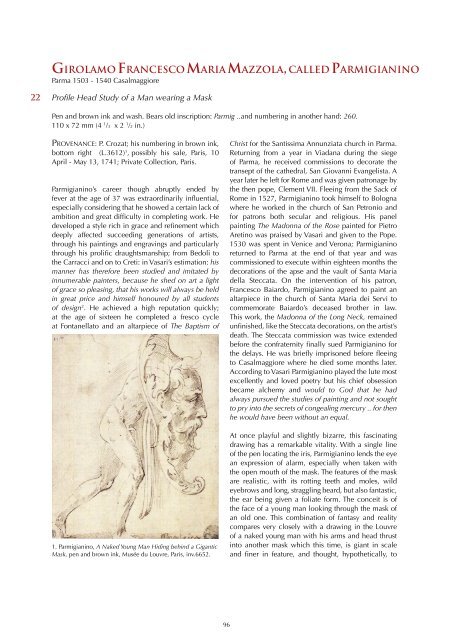You also want an ePaper? Increase the reach of your titles
YUMPU automatically turns print PDFs into web optimized ePapers that Google loves.
Girolamo Francesco Maria Mazzola, called Parmigianino<br />
Parma 1503 - 1540 Casalmaggiore<br />
22<br />
Profile Head Study of a Man wearing a Mask<br />
Pen and brown ink and wash. Bears old inscription: Parmig ..and numbering in another hand: 260.<br />
110 x 72 mm (4 1 /3 x 2 1 /2 in.)<br />
Provenance: P. Crozat; his numbering in brown ink,<br />
bottom right (L.3612) 1 , possibly his sale, Paris, 10<br />
April - May 13, 1741; Private Collection, Paris.<br />
Parmigianino’s career though abruptly ended by<br />
fever at the age of 37 was extraordinarily influential,<br />
especially considering that he showed a certain lack of<br />
ambition and great difficulty in completing work. He<br />
developed a style rich in grace and refinement which<br />
deeply affected succeeding generations of artists,<br />
through his paintings and engravings and particularly<br />
through his prolific draughtsmanship; from Bedoli to<br />
the Carracci and on to Creti: in Vasari’s estimation: his<br />
manner has therefore been studied and imitated by<br />
innumerable painters, because he shed on art a light<br />
of grace so pleasing, that his works will always be held<br />
in great price and himself honoured by all students<br />
of design 2 . He achieved a high reputation quickly;<br />
at the age of sixteen he completed a fresco cycle<br />
at Fontanellato and an altarpiece of The Baptism of<br />
1. Parmigianino, A Naked Young Man Hiding behind a Gigantic<br />
Mask, pen and brown ink, Musée du Louvre, Paris, inv.6652.<br />
Christ for the Santissima Annunziata church in Parma.<br />
Returning from a year in Viadana during the siege<br />
of Parma, he received commissions to decorate the<br />
transept of the cathedral, San Giovanni Evangelista. A<br />
year later he left for Rome and was given patronage by<br />
the then pope, Clement VII. Fleeing from the Sack of<br />
Rome in 1527, Parmigianino took himself to Bologna<br />
where he worked in the church of San Petronio and<br />
for patrons both secular and religious. His panel<br />
painting The Madonna of the Rose painted for Pietro<br />
Aretino was praised by Vasari and given to the Pope.<br />
1530 was spent in Venice and Verona; Parmigianino<br />
returned to Parma at the end of that year and was<br />
commissioned to execute within eighteen months the<br />
decorations of the apse and the vault of Santa Maria<br />
della Steccata. On the intervention of his patron,<br />
Francesco Baiardo, Parmigianino agreed to paint an<br />
altarpiece in the church of Santa Maria dei Servi to<br />
commemorate Baiardo’s deceased brother in law.<br />
This work, the Madonna of the Long Neck, remained<br />
unfinished, like the Steccata decorations, on the artist’s<br />
death. The Steccata commission was twice extended<br />
before the confraternity finally sued Parmigianino for<br />
the delays. He was briefly imprisoned before fleeing<br />
to Casalmaggiore where he died some months later.<br />
According to Vasari Parmigianino played the lute most<br />
excellently and loved poetry but his chief obsession<br />
became alchemy and would to God that he had<br />
always pursued the studies of painting and not sought<br />
to pry into the secrets of congealing mercury .. for then<br />
he would have been without an equal.<br />
At once playful and slightly bizarre, this fascinating<br />
drawing has a remarkable vitality. With a single line<br />
of the pen locating the iris, Parmigianino lends the eye<br />
an expression of alarm, especially when taken with<br />
the open mouth of the mask. The features of the mask<br />
are realistic, with its rotting teeth and moles, wild<br />
eyebrows and long, straggling beard, but also fantastic,<br />
the ear being given a foliate form. The conceit is of<br />
the face of a young man looking through the mask of<br />
an old one. This combination of fantasy and reality<br />
compares very closely with a drawing in the Louvre<br />
of a naked young man with his arms and head thrust<br />
into another mask which this time, is giant in scale<br />
and finer in feature, and thought, hypothetically, to<br />
96
















